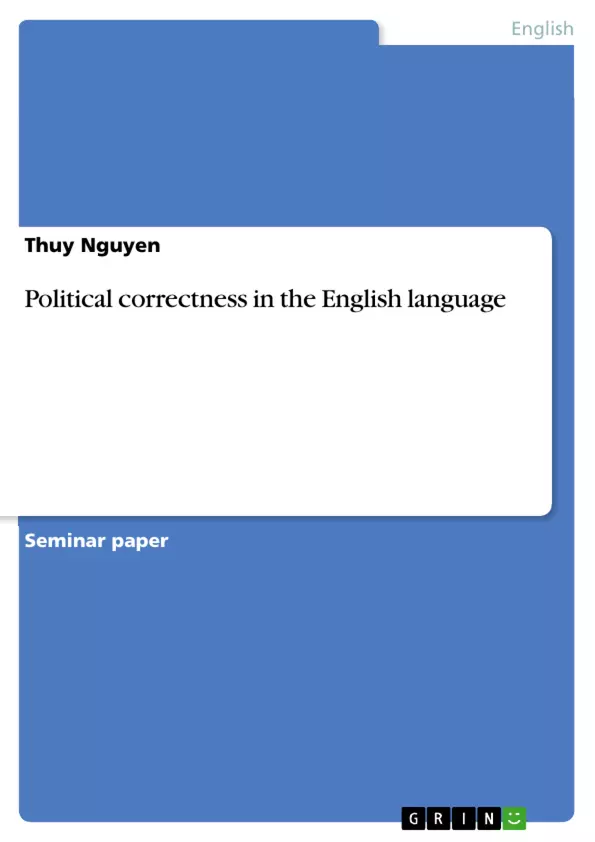In London during the 1980ies there were reports in the right-wing press, that socialist local councils like Hackney Council had to banish the word manhole by order of its Women’s Committee since the term was meant to be sexist. This is just one out of many incidences that came up during the political correctness debate. Since the eighties this phenomenon has occurred on the American campuses and developed rapidly to a publicly debated subject. This essay will deal with the phenomenon of the political correctness in the English language with the main focus on gender questions and feminist linguistics. The central question is if expressions like policemen or phrases like to be the master of the situation are really conceived as sexist by the majority of people and if replacing those by terms like “police officers” can solve the problem of sexist language use. Have the efforts to regulate or reform language been successful and can language be at all non-sexist or even neutral?
First of all, the term political correctness and politically correct are placed into a historical context explaining its roots and development before trying to define the concept. Furthermore, the importance of the political correctness debate for the Women’s Liberation Movement and the development of feminist linguistics will be explained.
The third chapter explains on which assumptions and theories the claimed language change is based on. The relation between language use and perception of the individual or of a group plays a central part. In the context of the political correctness debate the central question is in how far sexist language use, representation, the naming or not naming of women effects the perception and thinking of people.
The fourth chapter gives a description of the measures that were taken in order to influence language and language use. On the one hand, measures aimed at the regulation and sanction of sexist language and on the other hand, some more moderate and liberal measures intended the reformation of language in order to achieve more equality between women and men on a linguistic level. In how far have these measures been successful in increasing the awareness for discriminating language use?
Inhaltsverzeichnis (Table of Contents)
- Introduction
- Definition and historical background
- Political correctness
- Historical development of the terms Political Correctness and Political Correct
- Definition
- Women's Liberation Movement and Feminist linguistic criticism
- Political correctness
- Language and thinking: Explaining the need for a language change
- The Sapir-Whorf-hypothesis
- The common gender/generic masculine
- Measures of political correctness: Speech codes and language reforms
- Speech codes
- Legitimation of speech regulations
- Arguments against speech regulations
- Guidelines for non-sexist language
- Development and purpose
- The Handbook of Non-Sexist Writing
- Effects and reactions
- Speech codes
- Conclusion
- References
Zielsetzung und Themenschwerpunkte (Objectives and Key Themes)
This essay examines the phenomenon of political correctness in the English language, focusing on gender issues and feminist linguistics. The central question is whether terms like "policemen" or phrases like "to be the master of the situation" are truly perceived as sexist by most people and if replacing them with terms like "police officers" can successfully address the issue of sexist language use. The essay explores whether efforts to regulate or reform language have been successful and whether language can be truly non-sexist or neutral.- The historical development and definition of the term "political correctness"
- The relationship between political correctness and the Women's Liberation Movement and feminist linguistics
- The theoretical foundation for language change, particularly the relationship between language use and individual and group perception
- Measures taken to influence language use, including speech codes and guidelines for non-sexist language
- The effectiveness of these measures in raising awareness of discriminatory language use
Zusammenfassung der Kapitel (Chapter Summaries)
The first chapter introduces the concept of political correctness through an example from the 1980s in London. It sets the stage for exploring the phenomenon's origins, evolution, and impact, particularly within the context of gender and feminist linguistics.
The second chapter delves into the historical development and definition of the term "political correctness," tracing its origins to Marxist-Leninist vocabulary and its later adoption by reform and civil rights movements. The chapter also highlights the term's evolution and the challenges in defining it due to its multifaceted nature.
The third chapter focuses on the theoretical underpinnings of the argument for language change. It examines the Sapir-Whorf hypothesis and the impact of common gender and generic masculine language on individual and group perception.
The fourth chapter explores the different measures employed to influence language use. It examines the use of speech codes, both their justification and the arguments against them, as well as the development and impact of guidelines for non-sexist language. The chapter also delves into the purpose and effects of the Handbook of Non-Sexist Writing.
Schlüsselwörter (Keywords)
The essay centers around the key concepts of political correctness, feminist linguistics, gender, language change, speech codes, non-sexist language, and the impact of language on perception. It examines the historical context, theoretical foundations, and practical measures associated with the movement for linguistic reform and its implications for achieving gender equality in language.- Arbeit zitieren
- Thuy Nguyen (Autor:in), 2007, Political correctness in the English language, München, GRIN Verlag, https://www.grin.com/document/115796



